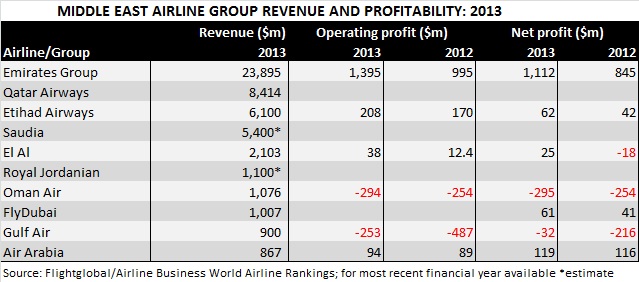In the Middle East carriers lifted revenues to $53 million. At almost 10% it is the highest rate of revenue growth of any of the regions in this year’s Airline Business/Flightglobal World Airline Rankings.
It is the three big Gulf carriers which continue to make the running. Emirates, Etihad Airways and Qatar Airways continue to expand rapidly in their own right – and the order bonanza at last November’s Dubai air show underlines their intent to continue.

But each too has looked to grow through partnerships over the last year. Etihad’s is the most obvious example. Darwin Airline, JAT Airways and Jet Airways have all joined the Etihad camp over the last year and are set to be followed by Alitalia, while several others started codeshares.
Qatar Airways became the first of the big Gulf three to join an alliance after teaming up with Oneworld. Emirates – while resolutely independent, is now more than a year into its tie-up with Qantas.
This continues the growth of these carriers, notably in key Asian markets.
Emirates too is growing its low-cost unit, Flydubai. The airline, which carried nearly 7 million passengers in 2013, also placed a landmark order for up to 100 Boeing 737 Max aircraft at last year’s Dubai air show.
In particular, it is developing short-haul connections into Dubai from secondary cities, both from the Middle East and from key markets like India and Russia. Qatar Airways meanwhile is still to start its own short-haul venture, a domestic Saudi operation under new domestic licences granted in the country. Al Maha hopes to launch before year-end and operate an eight strong fleet of A320s by the end of 2015, rising to 30 by 2017.
A second planned start-up, Saudi Gulf, earlier this year placed orders for A320s and Bombardier CSeries.
Elsewhere, some of the region’s restructuring carriers are reporting some signs of progress. Kuwait Airways, under new chief executive Rasha Al Roumi, plans to cut 1,000 jobs this year, and has placed orders for 10 Airbus A350-900s and 15 A320neos.
Gulf Air’s long-running restructuring efforts gained some traction in the last year, halving its losses in 2013. But fortunes took a turn for the worse at Royal Jordanian. Chief executive Amer Hadidi quit in April after less than two years in the role and the airline is reported to have lost $50 million in 2013, though it has not yet released its 2013 results.
Source: Cirium Dashboard











































